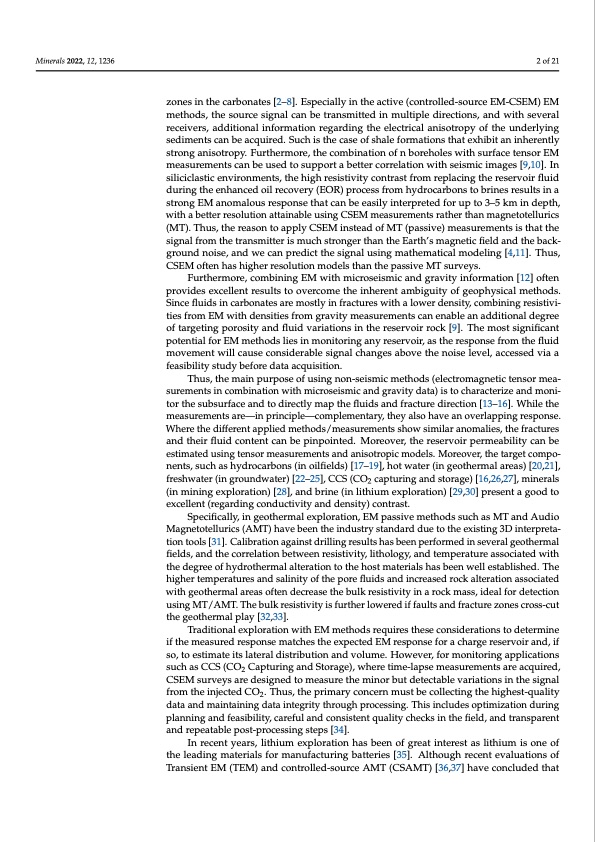
PDF Publication Title:
Text from PDF Page: 002
Minerals 2022, 12, 1236 2 of 21 zones in the carbonates [2–8]. Especially in the active (controlled-source EM-CSEM) EM methods, the source signal can be transmitted in multiple directions, and with several receivers, additional information regarding the electrical anisotropy of the underlying sediments can be acquired. Such is the case of shale formations that exhibit an inherently strong anisotropy. Furthermore, the combination of n boreholes with surface tensor EM measurements can be used to support a better correlation with seismic images [9,10]. In siliciclastic environments, the high resistivity contrast from replacing the reservoir fluid during the enhanced oil recovery (EOR) process from hydrocarbons to brines results in a strong EM anomalous response that can be easily interpreted for up to 3–5 km in depth, with a better resolution attainable using CSEM measurements rather than magnetotellurics (MT). Thus, the reason to apply CSEM instead of MT (passive) measurements is that the signal from the transmitter is much stronger than the Earth’s magnetic field and the back- ground noise, and we can predict the signal using mathematical modeling [4,11]. Thus, CSEM often has higher resolution models than the passive MT surveys. Furthermore, combining EM with microseismic and gravity information [12] often provides excellent results to overcome the inherent ambiguity of geophysical methods. Since fluids in carbonates are mostly in fractures with a lower density, combining resistivi- ties from EM with densities from gravity measurements can enable an additional degree of targeting porosity and fluid variations in the reservoir rock [9]. The most significant potential for EM methods lies in monitoring any reservoir, as the response from the fluid movement will cause considerable signal changes above the noise level, accessed via a feasibility study before data acquisition. Thus, the main purpose of using non-seismic methods (electromagnetic tensor mea- surements in combination with microseismic and gravity data) is to characterize and moni- tor the subsurface and to directly map the fluids and fracture direction [13–16]. While the measurements are—in principle—complementary, they also have an overlapping response. Where the different applied methods/measurements show similar anomalies, the fractures and their fluid content can be pinpointed. Moreover, the reservoir permeability can be estimated using tensor measurements and anisotropic models. Moreover, the target compo- nents, such as hydrocarbons (in oilfields) [17–19], hot water (in geothermal areas) [20,21], freshwater (in groundwater) [22–25], CCS (CO2 capturing and storage) [16,26,27], minerals (in mining exploration) [28], and brine (in lithium exploration) [29,30] present a good to excellent (regarding conductivity and density) contrast. Specifically, in geothermal exploration, EM passive methods such as MT and Audio Magnetotellurics (AMT) have been the industry standard due to the existing 3D interpreta- tion tools [31]. Calibration against drilling results has been performed in several geothermal fields, and the correlation between resistivity, lithology, and temperature associated with the degree of hydrothermal alteration to the host materials has been well established. The higher temperatures and salinity of the pore fluids and increased rock alteration associated with geothermal areas often decrease the bulk resistivity in a rock mass, ideal for detection using MT/AMT. The bulk resistivity is further lowered if faults and fracture zones cross-cut the geothermal play [32,33]. Traditional exploration with EM methods requires these considerations to determine if the measured response matches the expected EM response for a charge reservoir and, if so, to estimate its lateral distribution and volume. However, for monitoring applications such as CCS (CO2 Capturing and Storage), where time-lapse measurements are acquired, CSEM surveys are designed to measure the minor but detectable variations in the signal from the injected CO2. Thus, the primary concern must be collecting the highest-quality data and maintaining data integrity through processing. This includes optimization during planning and feasibility, careful and consistent quality checks in the field, and transparent and repeatable post-processing steps [34]. In recent years, lithium exploration has been of great interest as lithium is one of the leading materials for manufacturing batteries [35]. Although recent evaluations of Transient EM (TEM) and controlled-source AMT (CSAMT) [36,37] have concluded thatPDF Image | First High-Power CSEM

PDF Search Title:
First High-Power CSEMOriginal File Name Searched:
minerals-12-01236-v2.pdfDIY PDF Search: Google It | Yahoo | Bing
Product and Development Focus for Infinity Turbine
ORC Waste Heat Turbine and ORC System Build Plans: All turbine plans are $10,000 each. This allows you to build a system and then consider licensing for production after you have completed and tested a unit.Redox Flow Battery Technology: With the advent of the new USA tax credits for producing and selling batteries ($35/kW) we are focussing on a simple flow battery using shipping containers as the modular electrolyte storage units with tax credits up to $140,000 per system. Our main focus is on the salt battery. This battery can be used for both thermal and electrical storage applications. We call it the Cogeneration Battery or Cogen Battery. One project is converting salt (brine) based water conditioners to simultaneously produce power. In addition, there are many opportunities to extract Lithium from brine (salt lakes, groundwater, and producer water).Salt water or brine are huge sources for lithium. Most of the worlds lithium is acquired from a brine source. It's even in seawater in a low concentration. Brine is also a byproduct of huge powerplants, which can now use that as an electrolyte and a huge flow battery (which allows storage at the source).We welcome any business and equipment inquiries, as well as licensing our turbines for manufacturing.| CONTACT TEL: 608-238-6001 Email: greg@infinityturbine.com | RSS | AMP |